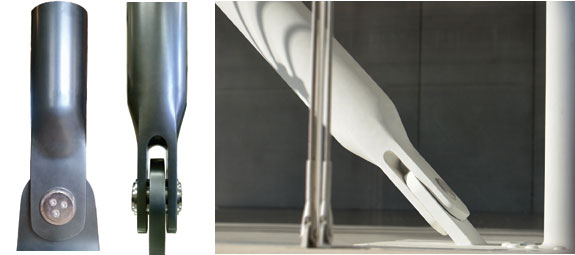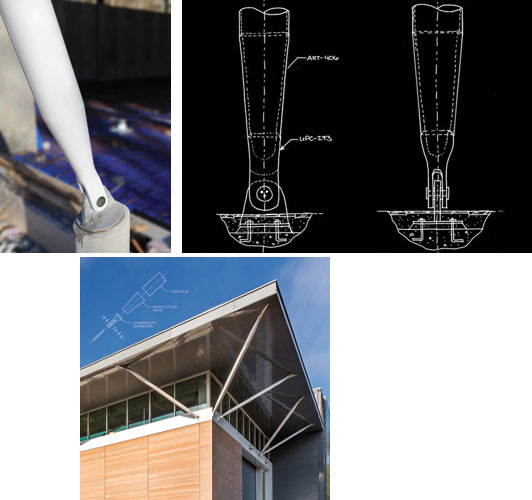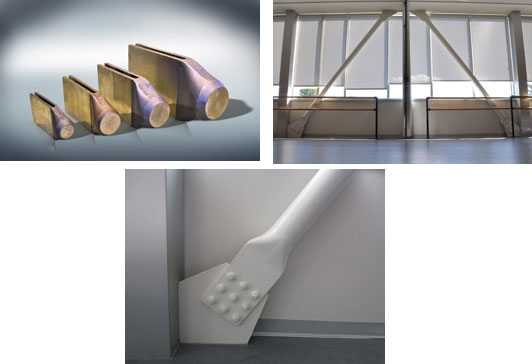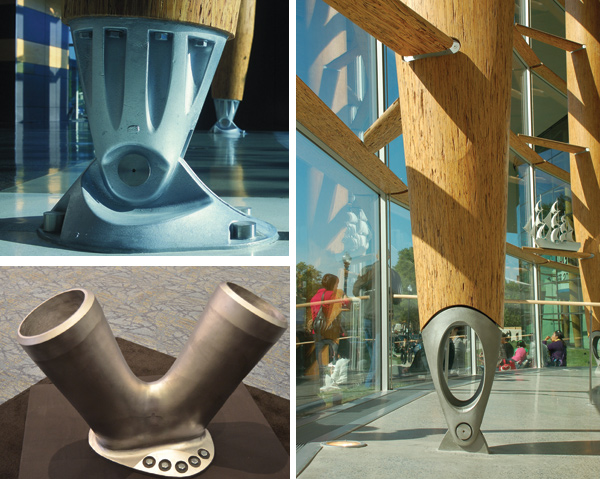Structural Steel Cast Connections
Types of Cast Steel Connections
While all cast steel connections will share the attributes and production process already discussed, different types of connectors are made for different building design conditions. The four most common types are universal pin connectors, architectural tapers, high-strength connectors, and custom cast connectors.
Universal Pin Connectors (UPC)
In many cases, the ideal structural connection from an architectural perspective is not a welded or bolted plate, rather it is a “true-pin” connection. While that ideal shape is difficult to achieve with flat or rolled steel, it is easily achieved with cast steel. Hence, universal pin connectors (UPCs) have become readily available in many sizes as standard, off-the-shelf cast connectors for AESS. They have become popular in a number of design schemes because they allow for a final appearance that provides elegance, simplicity, and consistency.

Photos courtesy of CAST CONNEX and Terri Meyer Boake
Universal pin connectors are standardized cast products that are welded to the end of a hollow structural section (HSS).
The primary benefit of a true pin connection is that it allows for any geometric angle of connection which is particularly useful in cross bracing or other angular structure situations. And since the pin rotates freely until secured in place, field adjustment of the pin and angle is easily accommodated. On a broader basis, UPCs are readily used at the ends of any structural element carrying tension and/or compression, meaning that they are suitable for use at the ends of columns, braces, struts, ties, or any other common structural element where a true pin load connection is desired. They have often been used as part of the overall structural system for entrance canopies, to connect web members of large trusses, as support connectors in specialty stairs, and at the ends of exposed braces that are part of the building's primary lateral force resistance system.
Cast UPCs are commonly sleek, clevis-type standardized fittings designed to connect to hollow structural section (HSS) elements. The connectors are generally carefully sculpted to provide a smooth transitional geometry that reflects the natural idealized flow of structural forces. The use of cast UPCs welded to HSS elements allows for a true pin connection and overcomes the inherent difficulty of trying to do so directly within the HSS element alone. Where aesthetics are a particular concern, the use of UPCs greatly simplifies the design, detailing, and fabrication of architecturally exposed structural connections while significantly improving the aesthetic appearance of the finished assembly. A complete UPC connection will require some additional hardware beyond just the cast portion. Specifically, they will need the associated carbon steel or stainless steel pins that insert through the connector and a base element. To work properly and hold the pin in place, stainless steel washers, cap plates, and cap screws are all generally required as well. Manufacturers have recognized this need and commonly supply all of this related hardware for a complete connection.
Some of the advantages of using UPCs include an aesthetic that provides elegant, smooth, curving transitions from every viewpoint. Properly designed, they can provide eye-catching end connections with a known cost, unlike traditional AESS connections which have been known to escalate in cost, even after the bid is awarded. Part of the cost improvement comes from dramatically simplified fabrication and a fraction of the grinding that typically accompanies AESS. Whether standard or custom UPCs are used, the casting process yields duplicate identical pieces to provide a consistent and reliable architectural appearance. And to make structural calculations and sizing easier, common connection details have been analyzed by manufacturers who can provide tabulated connection capacities.
Cast Architectural Tapers
Cast architectural tapers are conical, hollowed, cast structural steel members that are tapered in shape. They are designed to connect to the end of round HSS members, typically those acting in compression, for use in architecturally exposed structural steel applications. Cast architectural tapers can be used, for example, at the ends of exposed steel columns in a building's atrium. By combining universal pin connectors with architectural tapers, an aesthetic can be realized where the overall HSS member appears more slender. The smaller end condition also allows for a smaller UPC to be used.
Conventional fabrication of hollow conical steel tapers is difficult at best since it involves cold or hot forming/bending flat plate into a conical shape. Often steel fabricators and contractors will shy away from projects calling for such details if they don't feel comfortable carrying out the fabrication. By contrast, cast architectural tapers are easily welded to the end of round HSS tubes by steel fabricators and installers. Once assembled and welded, the joints can be ground smooth to create an elegant finished structural element. Due to the relative ease of fabrication and installation, cast architectural tapers have become readily available and cost effective. They are typically consistent in appearance and quality by virtue of the casting of standardized pieces.

Images courtesy of CAST CONNEX and Ellenzweig
Architectural taper transitioning between a universal pin connector and a hollow structural section (HSS) tube.
High-Strength Connectors (HSC)
Not all structural loading conditions call for the use of pin connections. Some require a fully rigid connection that is tolerant of a variety of forces which may include seismic, particularly in concentric braced structural frames. The conventional manner of addressing this need is to engineer detailed connections that often require connection reinforcement and the field welding of cross bracing to gusset plates which have been fabricated onto steel beams and columns. Such field welding requires skilled labor and an independent special inspection of the completed welds. All of this makes such conventionally fabricated connections rather complex and costly. By comparison, cast steel connection products have been developed that are simpler, work better, and create a lower cost connection overall.

Images courtesy of CAST CONNEX
High-strength connectors provide a rigid bolted connector that is suitable for addressing seismic and other loading conditions.
Cast steel high-strength connectors are standardized brace end connectors that accommodate a bolted double-shear connection between round HSS braces and a typical corner gusset plate. They are available in different standard sizes and capacities to suit a range of loading conditions. The modular design of these connectors minimizes detailing and accelerates fabrication of the steel structure. They are available as pre-designed and detailed connections which dramatically reduces engineering time and effort. During construction, the cast HSCs eliminate the need to field weld braces to the frame, hence they significantly speed erection and reduce the cost of special inspections. Because they are fully engineered connections, they can readily demonstrate conformance to code-listed connections that meet all of the requirements of AISC standards and guidelines to provide high-strength, functional connections for earthquake-resistant braced frame buildings.
Perhaps most significantly, cast HSCs are typically designed to eliminate shear lag in the connection. The AISC defines shear lag as behavior at an end connection of a tension member where some but not all of the cross-sectional elements are connected. This can mean that the actual effective area of the connection that is tension-resisting may be less than the full calculated net area. Cast HSCs are intended to have a full penetration shop-welded joint between the connector and tubular brace member which thus assures that the full cross-sectional area is available to resist all forces, thus eliminating the shear lag effect. This means that no connection reinforcement is required and the common iterative design process for determining reinforcement plates is eliminated. Overall the final joint provides improved reliability and a simplified connection design using standardized, pre-engineered cast steel pieces.
Although intended to be functional, cast HSCs also offer a unique aesthetic, which can be suitable for use in some AESS applications. Although the bolted connection is visible, it is an effective, compact connection which is consistent with a high-tech or utilitarian aesthetic without all of the visual clutter or variations found in conventional connections. HSCs also provide a compact gusset connection which reduces the likelihood of interferences with non-structural elements of the building.
Custom Castings
Thus far we have reviewed mostly standard types of cast connections that are commonly available. As design teams are faced with bigger challenges or simply choose to get more creative about exposed structures, it is important to know that it is entirely possible to create completely custom steel cast connections that allow the realization of a design vision in freeform architecturally exposed structural steel. In some cases, the custom castings may be variations on the UPCs or HSCs already discussed. In others, design conditions may suggest completely custom castings, giving designers the ability to create unique and even iconic structures. Custom castings are appropriately considered for architecturally exposed connections, particularly for connecting HSS elements or to mate between various materials (i.e. steel to timber). They are also the best solution for complex connections subjected to heavy loading from a variety of structural members aligned in different directions. Structurally, they can be excellent solutions where increased connection stiffness is required, where fatigue critical connections are involved, or where advanced components provide specific performance or function (i.e. rockers, couplers, dissipaters, etc.).
If it is determined that custom castings offer the best design solution, then it will be critically important to work throughout the design process with a firm or manufacturer that can provide complete design or design-build services for custom cast steel components. Such a company will need to provide services that are not commonly performed by conventional architecture and engineering firms, namely, three-dimensional industrial design and modeling of cast elements, finite element stress analysis for the components, steel connection design, casting detailing, non-destructive examination specification writing, and in some cases, even destructive structural testing of full-scale components and assemblages. It will also be important that they are able to provide cast steel production and assessment with a full understanding of steel casting technologies. Foundries don't typically have the people on staff to undertake structural engineering and design work, since they are mostly staffed with process engineers and metallurgists who understand how to make the castings but not how to design buildings that use them. Instead, a company needs to be chosen that can work as part of the design team for custom cast steel components to ensure that they provide the desired aesthetic appearance, carry loads safely and efficiently, integrate with the structural steel framing of the building, are capable of being cast using best practices, and remain economical.

Photos courtesy of CAST CONNEX and Fast+Epp
Custom cast connectors are suitable for connecting to steel structural members or to other structural materials such as structural timber.









